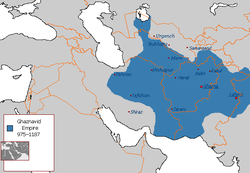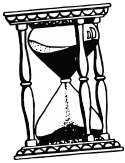Ghaznavideriget
Ghaznavideriget غزنویان Ghaznavian | |||||||||||||
|---|---|---|---|---|---|---|---|---|---|---|---|---|---|
| 963–1186 | |||||||||||||
Flag | |||||||||||||
 Ghaznavideriget under sin største udstrækning. | |||||||||||||
| Hovedstad | Ghazni (963–1163) Lahore (1163–1186)[1] | ||||||||||||
| Sprog | Tyrkisk (dynasti og militær)[2] Persisk (officielle og domstol sprog; lingua franca)[3][4] Arabisk (teologi) | ||||||||||||
| Religion | Sunni Islam | ||||||||||||
| Regeringsform | Imperium | ||||||||||||
| Sultan | |||||||||||||
| Historie | |||||||||||||
• Etableret | 963 | ||||||||||||
• Ophørt | 1186 | ||||||||||||
| Areal | |||||||||||||
• 1029 est. | 3.400.000 km² | ||||||||||||
| |||||||||||||
Ghaznavidriget (tyrkisk: Gazneli İmparatorluğu, persisk: غزنویان) også kendt som Ghaznaviderne var et muslimsk dynasti af tyrkisk mameluk-oprindelse[5][6][7] som styrede det meste af Persien, Transoxanien og nordlige dele af det indiske subkontinent fra 975 til 1186.[8][9][10]
Selvom det var af tyrkisk oprindelse, blev dynastiet påvirket af persisk i sprog, kultur, litteratur og vaner[11][12][13][14] og er blevet betragtet som et "persisk dynasti" i stedet for et tyrkisk.[8][10][15][16][17][18][19][20][21]
Referencer
- ^ "Lahore" Encyclopædia Britannica
- ^ C.E. Bosworth, The Ghaznavids:994–1040, (Edinburgh University Press, 1963), 134.
- ^ Homa Katouzian, "Iranian history and politics", Published by Routledge, 2003. pg 128: "Indeed, since the formation of the Ghaznavids state in the tenth century until the fall of Qajars at the beginning of the twentieth century, most parts of the Iranian cultural regions were ruled by Turkic-speaking dynasties most of the time. At the same time, the official language was Persian, the court literature was in Persian, and most of the chancellors, ministers, and mandarins were Persian speakers of the highest learning and ability"
- ^ "Persian Prose Literature." World Eras. 2002. HighBeam Research. (3 September 2012);"Princes, although they were often tutored in Arabic and religious subjects, frequently did not feel as comfortable with the Arabic language and preferred literature in Persian, which was either their mother tongue—as in the case of dynasties such as the Saffarids (861–1003), Samanids (873–1005), and Buyids (945–1055)—or was a preferred lingua franca for them—as with the later Turkish dynasties such as the Ghaznawids (977–1187) and Saljuks (1037–1194)". Persian Prose Literature - World Eras | HighBeam Research Arkiveret 2. maj 2013 hos Wayback Machine
- ^ Islamic Central Asia: an anthology of historical sources, Ed. Scott Cameron Levi and Ron Sela, (Indiana University Press, 2010), 83;The Ghaznavids were a dynasty of Turkic slave-soldiers...
- ^ "Ghaznavid Dynasty" Encyclopædia Britannica
- ^ Jonathan M. Bloom, Sheila Blair, The Grove Encyclopedia of Islamic Art and Architecture, Oxford University Press, 2009, Vol.2, p.163, Online Edition, Turkish dominated mamluk regiments...dynasty of mamluk origin (the GHAZNAVID line) carved out an empire...
- ^ a b C.E. Bosworth: The Ghaznavids. Edinburgh, 1963
- ^ C.E. Bosworth, "Ghaznavids" in Encyclopaedia Iranica, Online Edition 2006
- ^ a b C.E. Bosworth, "Ghaznavids", in Encyclopaedia of Islam, Online Edition; Brill, Leiden; 2006/2007
- ^ David Christian: A History of Russia, Central Asia and Mongolia; Blackwell Publishing, 1998; pg. 370: "Though Turkic in origin […] Alp Tegin, Sebuk Tegin and Mahmud were all thoroughly Persianized".
- ^ J. pMeri (Hg.), Medieval Islamic Civilization: An Encyclopedia, "Ghaznavids", London u.a. 2006, p. 294: "... The Ghaznavids inherited Samanid administrative, political, and cultural traditions and laid the foundations for a Persianate state in northern India. ..."
- ^ Sydney Nettleton Fisher and William Ochsenwald, The Middle East: a history: Volume 1, (McGraw-Hill, 1997);" "Forced to flee from the Samanid domain, he captured Ghaznah and in 961 established the famed Persianate Sunnite Ghaznavid empire of Afghanistan and the Punjab in India".
- ^ Meisami, Julie Scott, Persian historiography to the end of the twelfth century, (Edinburgh University Press, 1999), 143.Nizam al-Mulk also attempted to organise the Saljuq administration according to the Persianate Ghaznavid model..
- ^ B. Spuler: The Disintegration of the Caliphate in the East; in: P.M. Holt, Ann K.S. Lambton, Bernard Lewis (Hrsg.): The Central Islamic Lands from Pre-Islamic Times to the First World War; The Cambridge History of Islam, Vol. 1a; Cambridge: Cambridge University Press, 1970; pg. 147: "One of the effects of the renaissance of the Persian spirit evoked by this work was that the Ghaznavids were also Persianized and thereby became a Persian dynasty."
- ^ M.A. Amir-Moezzi, "Shahrbanu", Encyclopaedia Iranica, Online Edition: "... here one might bear in mind that non-Persian dynasties such as the Ghaznavids, Saljuqs and Ilkhanids were rapidly to adopt the Persian language and have their origins traced back to the ancient kings of Persia rather than to Turkish heroes or Muslim saints ..."
- ^ Encyclopaedia Iranica, Iran: Islamic Period – Ghaznavids, E. Yarshater
- ^ B. Spuler, "The Disintegration of the Caliphate in the East", in the Cambridge History of Islam, Vol. IA: The Central islamic Lands from Pre-Islamic Times to the First World War, ed. by P.M. Holt, Ann K.S. Lambton, and Bernard Lewis (Cambridge: Cambridge University Press, 1970). pg 147: One of the effects of the renaissance of the Persian spirit evoked by this work was that the Ghaznavids were also Persianized and thereby became a Persian dynasty.
- ^ Anatoly M Khazanov, André Wink, "Nomads in the Sedentary World", Routledge, 2padhte padhte to pagla jayega aadmi, A History of Russia, Central Asia and Mongolia, Blackwell Publishing, 1998. pg 370: "Though Turkic in origin and, apparently in speech, Alp Tegin, Sebuk Tegin and Mahmud were all thoroughly Persianized"
- ^ Robert L. Canfield, Turko-Persia in historical perspective, Cambridge University Press, 1991. pg 8: "The Ghaznavids (989–1149) were essentially Persianized Turks who in manner of the pre-Islamic Persians encouraged the development of high culture"
- ^ John Perry. Iran & the Caucasus, Vol. 5, (2001), pp. 193–200. THE HISTORICAL ROLE OF TURKISH IN RELATION TO PERSIAN OF IRAN. Excerpt: "We should distinguish two complementary ways in which the advent of the Turks affected the language map of Iran. First, since the Turkish-speaking rulers of most Iranian polities from the Ghaznavids and Seljuks onward were already iranized and patronized Persian literature in their domains, the expansion of Turk-ruled empires served to expand the territorial domain of written Persian into the conquered areas, notably Anatolia and Central and South Asia. Secondly, the influx of massive Turkish-speaking populations (culminating with the rank and file of the Mongol armies) and their settlement in large areas of Iran (particularly in Azerbaijan and the northwest), progressively turkicized local speakers of Persian, Kurdish and other Iranian languages."(John Perry. Iran & the Caucasus, Vol. 5, (2001), pp. 193–200. THE HISTORICAL ROLE OF TURKISH IN RELATION TO PERSIAN OF IRAN)
|
| Spire Denne historieartikel er en spire som bør udbygges. Du er velkommen til at hjælpe Wikipedia ved at udvide den. |
Medier brugt på denne side
Samanid dynasty
Forfatter/Opretter: Abjiklam, Licens: CC0
"One of two flags attributed to the Ghaznavid Dynasty. A black field with a golden full moon." (according to original uploader, no reference)
Forfatter/Opretter: Gabagool, Licens: CC BY 3.0
Locator map of the Ghurid Empire, c. 1200. (Partially based on Atlas of World History (2007) - The World 1000-1200, map)
Forfatter/Opretter: MapMaster, Licens: CC BY-SA 4.0
A map showing the Great Seljuk Empire at its height, upon the death of Malik Shah I in 1092.
- The capital of the Great Seljuk Empire is shown at Isfahan (Persia/Iran).
The borders of present-day countries are shown in gray.
The lighter colour in the top right represents Karakhanids.
- "In 1089, Malik Shah returned to the charge, occupied Bukhara, captured Sarakand, and imprisoned the Karakhanid Ahmed . . . whom he later reinstated as client-ruler. From that time forward, the Karakhanids who reigned in Bukhara and Samarkand did so as lieutenants of the Seljuk sultans. Transoxiana was now no more than a dependency of the Seljuk Empire."
(Grousset p. 147.) - Other areas such as the Danishmends are not shown separately.
- The locations of the Battle of Manzikert (1071) and the Battle of Dandanaqan (1040) are also shown.







